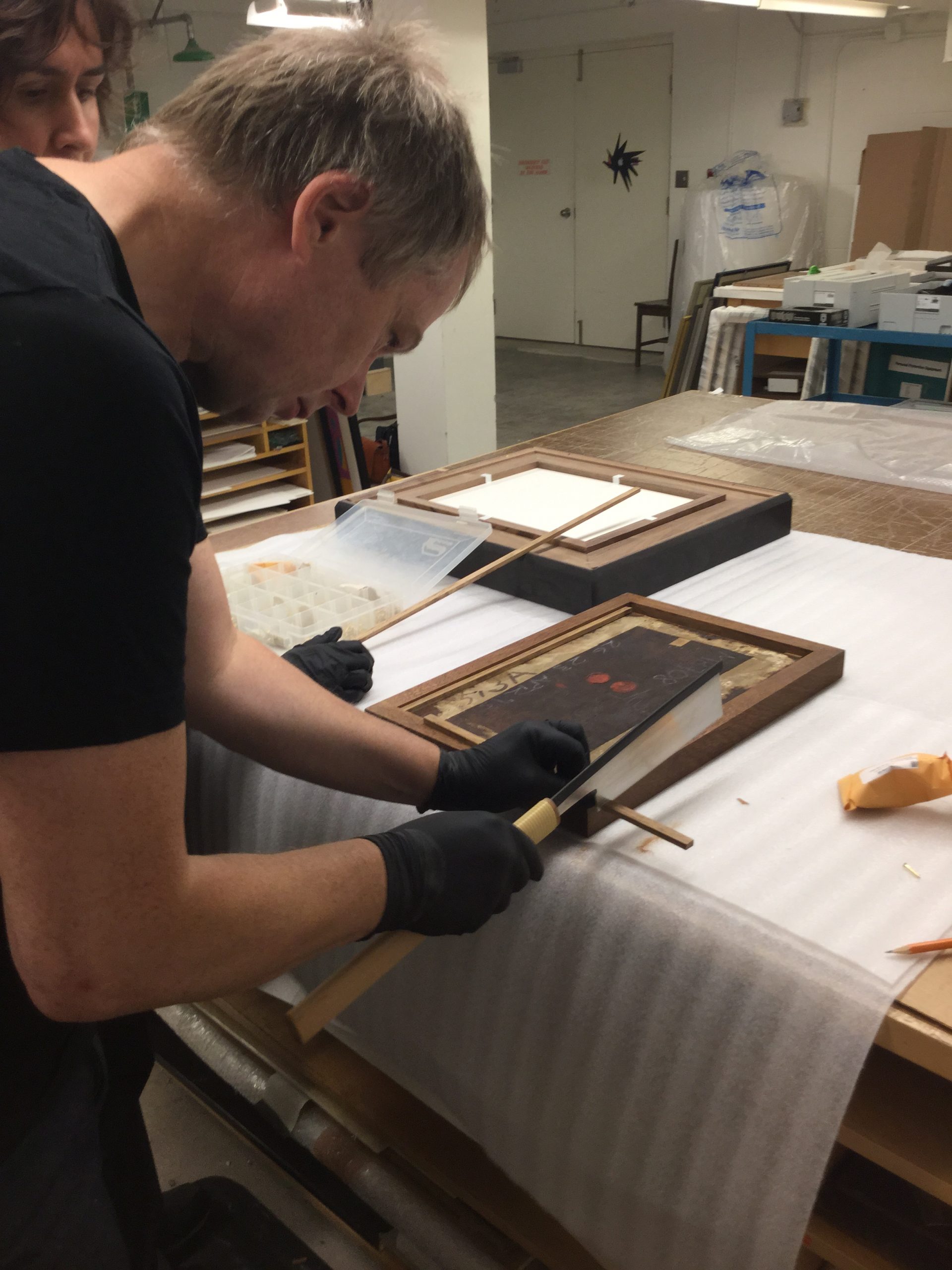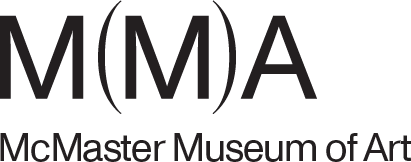Reframing Van Gogh and the Masters
November 23, 2015

In preparation for the exhibition The Unvarnished Truth, several of the paintings in McMaster’s collection were reframed – radically. This was done for a number of reasons, in consultation with the expert framing team at The Gilder in Toronto.
Van der Neer
The ornate French gilded frames on the Van Gogh and Van der Neer were not authentic to the period of Dutch oil paintings from the 19th and 17th centuries, respectively. The delicate rendering of the Van der Neer panel was taken into consideration when discussing its new frame, and it was decided that the profile (or moulding) needed to be soft and organic, in response to the fine details in the painting. The size of the frame was kept in relation to the dimensions of the panel, so as to not overpower the small work. After looking at various types of wood, including lovely soft pear wood, English Brown oak was selected. English oak has a more delicate, tighter grain than its American counterpart, and a richer brown colouring, due to a fungus that attacks the trees. A medium warm stain paired nicely with the painting, and the finishing touch was a fine strip of gilding around the outermost edge of the frame.

Aert van der Neer (Dutch, 1603/4-1677)
A Frozen Waterway with Villagers Playing Kolf and Skating and a Horsedrawn Sleigh, mid 17th Century, 23.8 x 37.7 cm, Oil on oak panel. Levy Bequest Purchase. Collection of McMaster Museum of Art
Van Gogh
We were excited at the prospect of creating an appropriate frame for the Van Gogh, as we had wanted to reframe it for some time. Various books on the artist were consulted in order to see what types of frames were used for works of this period (1885). Dutch 19th century frames can be quite substantial (wide), and simple in appearance. Taking into consideration the greater width of the frame, and the still life subject matter executed in tones of dark browns and golds, the wood chosen for the Van Gogh was also English oak, for its attractive tighter grain and brown colouring. Ultimately a medium stain was chosen, as it was decided a dark stain might make the painting appear even darker than it already is. To lighten the overall appearance and complement the golden highlights, a thin strip of gilded lining was placed along the inside edge of the frame.

Vincent van Gogh (Dutch, 1853-1890), Untitled, Still Life: Ginger Pot and Onions, 1885, 34.5 x 49.5 cm, Oil on canvas. Gift of Herman Levy, Esq., O.B.E. Collection of McMaster Museum of Art, McMaster University
Brouwer
The existing frame for The Drinker by the Workshop of Adriaen Brouwer was appropriate to its period, however the frame rebate overlapped the panel, covering the edges of the painting. Unframed, it seemed like the panel could ‘breathe’, and certain small (but not unimportant) details were visible. It was decided to ‘float’ the panel in the new frame, meaning that the work would be secured in such a way that all edges could be seen. There was visible wear along the edges of the painting from being framed so tightly for so long, but it was decided that this was negligible, as the overall appearance of the work would greatly benefit from the new frame. Looking at the (unstained) back of the old Brouwer frame, we could see it was beautiful, raw walnut. Walnut is a hardwood which has a rich colour and sands evenly to a superb finish, and was the obvious choice for this work.

Painting from the Workshop of Adriaen Brouwer (Flemish, 1605/6-1638), The Drinker / The Bitter Draught, c. 1635-1638, 34.3 x 27.1 cm, Oil on oak panel on oak cradle, Gift of Herman Levy, Esq., O.B.E. Collection of McMaster Museum of Art
The dark stain for the Brouwer was also chosen in relation to the period and style of the artwork, a Flemish portrait from the 17th century. The profile was chosen from the book Framing in the Golden Age, from the Rijksmuseum Amsterdam. We took a stained profile sample, brought in by Peter and Elizabeth from The Gilder during one of their visits during the production of the frames, and viewed it against the walls in our exhibition space to see how it would appear in gallery lighting. This brought the frame to life, as we could see how the profile would be lit, and it helped us to envision the overall design.

Glazing
We also took the opportunity to glaze, or install Plexiglas, on several of these paintings as they were being reframed. This was done to protect them in enclosed safe environments as they will be going on tour around the country next year and, down the road, it will help to preserve the longevity of the objects. The plexi we prefer to use is called Tru Vue Optium Museum Acrylic, a wonderful product that has very low glare, and seems to ‘disappear’ when the painting is properly hung and lit. It both protects the paintings and allows for an unencumbered view of the work.
– Julie Bronson, Collections Administrator, McMaster Museum of Art

McMaster Museum of Art wins Exhibition of the Year for The Clichettes: Lips, Wigs and Politics
December 2, 2025
On Monday, December 1, 2025, Galeries Ontario / Ontario Galleries (GOG) announced the winners of the 48th Annual GOG Awards and the McMaster Museum of Art (M(M)A) took away the top award for the Exhibition of the Year (Budget Over $50K) for the Fall 2024 exhibition The Clichettes: Lips, Wigs and Politics produced in partnership […]

The Creative Process: Well-being through art with the McMaster Museum of Art
August 22, 2025

McMaster Museum of Art Welcomes New Communications Officer Jeff Jung Sing Chow
July 11, 2025





